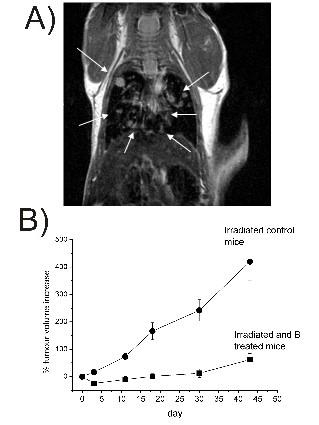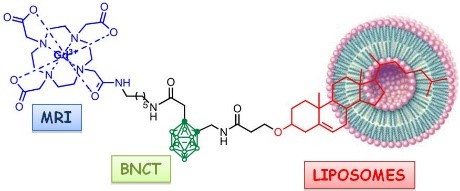Gadolinium/boron-based agents in imaging guided boron neutron capture therapy (BNCT)
A theranostic approach for the treatment of primary tumours and metastasis based on the use of Boron neutron capture therapy (BNCT) that combines low energy neutron irradiation with the presence of boron-containing compound at the targeted cells. The novel theranostic agents are able to maximize the selective uptake of boron atoms in tumour cells and, at the same time, to quantify boron distribution in the tumour and in other tissues by MRI.

A theranostic approach based on the use of a dual boron/Gd agent to improve the efficacy of Boron Neutron Capture Therapy in the lung cancer treatment.
This study aims at developing an innovative theranostic approach for lung tumor and metastases treatment, based on Boron Neutron Capture Therapy (BNCT). It relies on to the use of low density lipoproteins (LDL) as carriers able to maximize the selective uptake of boron atoms in tumor cells and, at the same time, to quantify the in vivo boron distribution by magnetic resonance imaging (MRI). Tumor cells uptake was initially assessed by ICP-MS and MRI on four types of tumor (TUBO, B16-F10, MCF-7, A549) and one healthy (N-MUG) cell lines. Lung metastases were generated by intravenous injection of a Her2+ breast cancer cell line (i.e. TUBO) in BALB/c mice and transgenic EML4-ALK mice were used as primary tumor model. After neutron irradiation, tumor growth was followed for 30-40 days by MRI. Tumor masses of boron treated mice increased markedly slowly than the control group.
 D. Alberti et al,
Nanomedicine: Nanotechnology, Biology, and Medicine 11 (2015)
741–750
D. Alberti et al,
Nanomedicine: Nanotechnology, Biology, and Medicine 11 (2015)
741–750
Theranostic Nanoparticles Loaded with Imaging Probes and Rubrocurcumin for Combined Cancer Therapy by Folate Receptor Targeting.
The combination of different therapeutic modalities is a promising option to combat the recurrence of tumors. In this study, polylactic and polyglycolic acid nanoparticles were used for the simultaneous delivery of a boron–curcumin complex (RbCur) and an amphiphilic gadolinium complex into tumor cells with the aim of performing boron and gadolinium neutron capture therapy (NCT) in conjunction with the additional antiproliferative effects of curcumin. Furthermore, the use of Gd complexes allows magnetic resonance imaging (MRI) assessment of the amount of B and Gd internalized by tumor cells. Poly(lactic-co-glycolic acid) (PLGA) nanoparticles were targeted to ovarian cancer (IGROV-1) cells through folate receptors, by including in the formulation a PEGylated phospholipid functionalized with the folate moiety.
NCT was performed on IGROV-1 cells internalizing 6.4 and 78.6 mgg1 of 10B and 157Gd, respectively. The synergic action of neutron treatment and curcumin cytotoxicity was shown to result in a significant therapeutic improvement.
D. Alberti et al, ChemMedChem 2017, 12, 1 – 9Synthesis of a carborane-containing cholesterol derivative and evaluation as a potential dual agent for MRI/BNCT applications.
In this study the synthesis and characterization of a new
dual, imaging and therapeutic, agent is proposed with the aim
of improving the efficacy of Boron Neutron Capture Therapy
(BNCT) in cancer treatment. The agent (Gd-B-AC01) consists of
a carborane unit (ten boron atoms) bearing a cholesterol unit
on one side (to pursue the incorporation into the liposome
bi-layer) and a Gd(III)/1,4,7,10-tetraazacyclododecane
monoamide complex on the other side (as a MRI reporter to
attain the quantification of the B/Gd concentration). In order
to endow the BNCT agent with specific delivery properties, the
liposome embedded with the MRI/BNCT dual probes has been
functionalized with a pegylated phospholipid containing a
folic acid residue at the end of the PEG chain. The vector
allows the binding of the liposome to folate receptors that
are overexpressed in many tumor types, and in particular, in
human ovarian cancer cells (IGROV-1). 
An in vitro test on IGROV-1 cells demonstrated that Gd-B-AC01 loaded liposomes are efficient carriers for the delivery of the MRI/BNCT probes to the tumor cells. Finally, the BNCT treatment of IGROV-1 cells showed that the number of surviving cells was markedly smaller when the cells were irradiated after internalization of the folate-targeted GdB10-AC01/liposomes.
D. Alberti et al, Org. Biomol. Chem., 2014, 12, 2457–2467